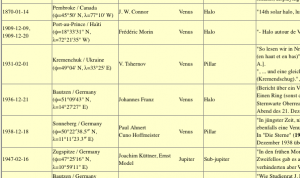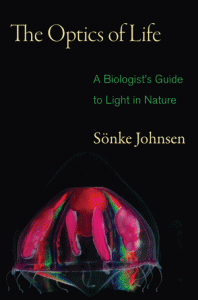(updated 26 Aug 2013 – final agenda)
Light and Color in Nature, 5–8 August 2013 at the University of Alaska Fairbanks
Monday, 5 August
Session 1: Introduction, 0900-1030, Kenneth Sassen Chair
Welcome by Robert McCoy, Director of the Geophysical Institute
Opening Remarks by Kenneth Sassen, Committee Chair
0930 Invited: Atmospheric optics at the early Geophysical Institute, Glenn Shaw
1000 Keynote: Noctilucent clouds – ice clouds at the edge of space in the polar summer, Richard Collins
Coffee break (continued registration), 1030-1100
Session 2: Historical Optics, 1100-1200, Joseph Shaw Chair
1100: 2.1 The 1665 orange halo of Huygens’s father, Gunther Konnen
1120: 2.2 The 35 minute green flash observed at Little America on 16 Oct 1929: a retrospective study, James Lock
1140: 2.3 The Nuremburg halo display of April 19, 1630, Eva Seidenfaden
Lunch (at the Geophysical Institute Globe Room), 1200-1300
1300 Invited: Cloud Forms, Stanley Gedzelman
Session 3: Scattering Interference Phenomena, 1330-1430, Stan Gedzelman Chair
1330: 3.1 Revisiting the corona, Philip Laven
1400: 3.2 The heiligenschein, John Adam and Philip Laven
Coffee Break, 1430-1500
Session 4: Ocean Color/Optics, 1500- 1640, Philip Laven Chair
1500: 4.1 Colors of thermal pools in Yellowstone National Park, Paul Nugent, Joseph Shaw and Michael Vollmer
1520: 4.2 Caustics due to complex water menisci, Charles Adler and James Lock
1540: 4.3 Improvement of remotely sensed Kd (PAR) of shallow turbid water in the Yellow Sea, Bumjun Kil and Stephan Howden
Public Optics Demonstration, 1730-1900, Kenneth Sassen Chair
Halomator and spectrodrom – a basement laboratory of atmospheric optics, by Michael Grossmann, Alexander Haussmann, and Elmar Schmidt
Conference Reception at the Museum of the North (light dinner), 1930-2100
Tuesday, 6 August
Registration, 0800-0900
Session 5: Ice Crystal Halos/Arcs, 0900-1030, Michael Vollmer Chair
0900: 5.1 Invited: “Lowitz Arcs Revisited”, Robert Greenler, Les Cowley, and Robert Gorkin
0930: 5.2 Halos due to scattering by randomly oriented crystals, Gunther Konnen
0950: 5.3 Brightness profile of the 22 degree halo, Dave Lynch
1010: 5.4 Pyramidal halo phenomenon in Virginia June 21st, 2010, Elmar Schmidt, T. Alan Clark, A. Haussmann, and Claudia Hinz
Coffee break, 1030-1100
Session 5 continued: Ice Crystal Halos/Arcs, 1100 -1200, Michael Vollmer Chair
1100: 5.5 Streetlight halos, Walter Tape
1120: 5.6 Parry’s arc from nearby light sources in Deadhorse, Alaska, Kenneth Sassen and Colin Triplett
1140: 5.7 Halo simulation progress report, Stanley Gedzelman
Lunch (at the Geophysical Institute Globe Room), 1200-1300
Session 5 continued: Ice Crystal Halos/Arcs, 1300-1350, Michael Vollmer Chair
1300: 5.8 Laboratory Demonstration, Position-related spectra within experimental parhelia: Simple hands-on experiments explaining the perceived color of sun dogs, K.-P. Mollmann and M. Vollmer
1330: 5.9 Brilliant colors from a white snow cover, Michael Vollmer and Joseph Shaw
Session 6: General Observations, 1350-1430, Gunther Konnen Chair
1350: 6.1 Unusual optical phenomena from mountain sites, Claudia Hinz
1410: 6.2 Establishment of the global meteopark system, Lai Bixing
Coffee Break, 1430-1500
Session 7 Biological Colors: 1530-1640, Robert Greenler Chair
1500: 7.1 On the purpose of color for living beings: a new theory of color organization, Katia Deiana and Baingio Pinna
1520: 7.2 How can a fish hide in the open ocean?, Robert Greenler
1540: 7.3 Iridescent colors in spider webs, H. Joachim Schlichting
1600: 7.4 Structural color of the butterfly wing scale, S. Yoshioka
1620: 7.5 Total internal reflection as solar protection for the Saharan desert ant Cataglyphis bombycina, Priscilla Simonis and Jean Pol Vigneron
Session 8 Mirages: 1640-1700, Robert Greenler Chair
1640: 8.1 Visible and invisible mirages: comparing inferior mirages in the visible and thermal infrared spectral range, Michael Vollmer, Joseph Shaw, Paul Nugent
Riverboat Discovery Chena River Excursion and Dinner, 1900-2200
Wednesday, 7 August
Session 9: Rainbows: 0900-1030, Walter Tape Chair
0900: 9.1 Invited: The natural tertiary rainbow- A photographic first, M. Grossmann
0930: 9.2 Photographic observation of a natural fifth-order rainbow, Harald Edens
0950: 9.3 Polarization and visibility of higher order rainbows, Gunther Konnen
1010: 9.4 Recent rainbow revelations, Robert Greenler
Coffee break, 1030-1100
Session 9 continued: Rainbows, 1100-1200, Walter Tape Chair
1100: 9.5 New insights into the rainbow, Part 1, Jean Louis Ricard, Peter Adams, and Jean Barckicke
1120: 9.6 New insights into the rainbow, Part 2, Jean Louis Ricard, Peter Adams, and Jean Barckicke
1140: 9.7 Observation, photogrammetry, and analysis of a twinned rainbow, Alexander Haussmann
Lunch (at the Geophysical Institute Globe Room), 1200-1300
Session 9 continued: Rainbows, 1300-1430, David Lynch Chair
1300: 9.8 A physically based rainbow simulator taking the background into consideration, Moon R. Jung
1320: 9.9 Influence of non-spherical raindrop shapes on higher order rainbows, Alexander Haussmann
1340: 9.10 Flashes of light below the dripping faucet: an optical signal from capillary oscillations of water drops, Thomas Timusk
1400: 9.11 Digital Imagery Forum, A post-Faustian review of digital imagery: the good, the bad, and the weird, Dave Lynch, Leader
Coffee Break, 1430-1500
Session 10: Atmospheric Color and Polarization, 1500-1720, Raymond Lee Chair
1500: 10.1 Seeing, adapting to, and reproducing the appearance of nature, Mark Fairchild
1520: 10.2 What is the spectrum of skylight polarization? Joseph Shaw and Nathan Pust
1540: 10.3 Measuring haze’s effects on the colors and visible-wavelength spectra of clear skies, Raymond Lee
1600: 10.4 Views affected by a wavy air-water surface, Yoav Y. Schechner
1620: 10.5 Simulating dark sunlit clouds, Stanley Gedzelman
1640: 10.6 Shadows, Dave Lynch
The Light & Color Official Slide Show (“pretty picture session”), 1715 to whenever
Thursday, 8 August
Session 11: Astronomical Optics, 0900-1030, Charles Adler Chair
0900: 11.1 Invited: Twilight’s Belt of Venus, by Raymond Lee
0930: 11.2 Visibility of Sirius in broad daylight, Gunther Konnen and Piet Stammes
0950: 11.3 Some elementary but surprising facts about the sun’s location in the sky, A. James Mallmann and Steven P. Mayer
1010: 11.4 Earthshine brightness and visibility, David Lynch
Coffee break, 1030-1100
Session 11 continued: Astronomical Optics, 1100-1200, Kenneth Sassen Chair
1100: 11.5 The use of light and color in astrophysical imaging, Travis A. Rector, Zoltan Levay, Lisa Frattare, Jayanne Engllish, and Kirk Pu-uohau-Pummill
1120: 11.6 Lunar eclipse photometry across the world – first correlations, Elmar Schmidt
1140: 11.7 Using light and color to detect life on Earth-like extra-solar planets, Eyal Schwartz, Stephen G. Lipson, and Erez N. Ribak
Concluding Remarks and Challenge, by Kenneth Sassen
Conference Concludes: 1215
Afternoon Tour of Chatanika gold mining area (lunch) and UAF Poker Flat Rocket Range


